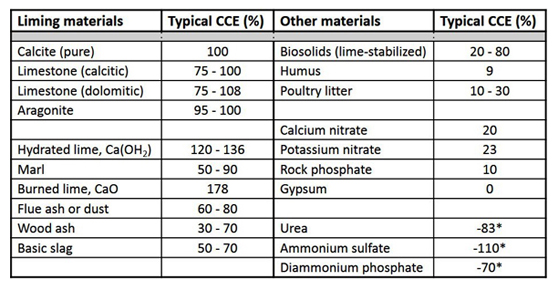- Grid sampling creates the most reliable VRT map for proper pH correction.
- Different pH correction capabilities exist for liming materials based on material type, and coarseness of grind or particle.
- Lime forces a chemical reaction in the soil with the carbonate portion of the lime material that allows calcium ions to displace tightly held hydrogen ions from the soil CEC and effectively neutralize soil pH to a favorable range.
- Fine limes need more frequent application solely due their ability to hold pH in the favorable range.
In previous editions of this newsletter we have addresses soil pH, nutrient availability and best methods for field measurement of pH values. Grid sampling presents the best unbiased method available to measure in field pH variation and to correct differing measures in a way that insures that under or over correct doesn’t further affect nutrient availabilities to the crops grown.
Many different liming materials exist for pH correction (Table 1) and they vary in their availability to raise soil pH to acceptable ranges. Acceptable pH ranges differ from state to state based on crops grown within local rotation schemes. Legumes used for forage purposes such as alfalfa need a higher end range of pH (6.8 to 7.0) than a crop rotation including only soybeans and corn (range of 6.0 to 6.5).

Calcium carbonate equivalent (CCE) is a system designed to compare the relative neutralizing value of liming materials as compared to calcite, where calcite is considered 100% CCE.Calcium carbonate causes a chemical reaction that removes tightly held H+ ions from the cation exchange sites in the soil (Diagram 2) resulting in the production of water and carbon dioxide and thus higher soil pH.

Some states use buffer pH to get an idea of the soils buffering capacity (ability to resist pH change), while other states group soil CEC’s (cation ion exchange capacities) into buffering capacities groups which is equally effective in determining lime needs.
Most lime application requirements are based on correction every four years.Lime materials require incorporation into the upper six inches of soil. The ability of lime applications to neutralize acidity relies on this incorporation as limes only move approximately two inches from point of application per growing season. Sandy soils require liming more often due to their low soil buffering capacities.
Coarseness of lime grind, which is the percent of lime passing thru 8, 30 & 60 mesh screen size, where mesh size= number of holes/ sq. in., determines the amount of time the lime will effectively hold pH (sustain the chemical reaction) in a favorable range given the soils buffering capacity. Finer limes (pelleted lime, liquid limes, slag, flu or fly ash or wood ash) will have shorter effective periods of times that they will maintain soil pH in these favorable ranges, thus requiring more frequent applications.
So now you understand liming materials, CCE’s, the chemical reaction that allows calcium ions to replace more tightly held H+ ions from the soil CEC and how often lime application will be needed to maintain pH in a favorable range based on crop rotation. Calculations for tons of lime needed to correct your given pH’s to the acceptable range and maintain them can be found in your local states publications.
Table 1 : Liming Materials and Calcium Carbonate Equivalent (CCE)
Diagram 2: Soil reaction to lime application, diagram by Dan Sullivan taken from “Applying Lime to Raise Soil pH for Crop Production (Western Oregon, byN.P. Anderson, J.M. Hart, D.M. Sullivan, N.W. Christensen, D.A. Horneck, and G.J. Pirelli, OSU Extension publication FG 52, Fertilizer and Lime Materials Fertilizer Guide”.